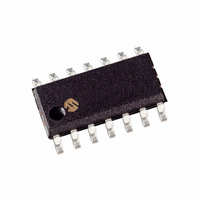MCP2120-I/SL Microchip Technology, MCP2120-I/SL Datasheet - Page 19

MCP2120-I/SL
Manufacturer Part Number
MCP2120-I/SL
Description
IC ENCODR/DECODR 2.5V IR 14-SOIC
Manufacturer
Microchip Technology
Type
Infrared Encoder/Decoderr
Specifications of MCP2120-I/SL
Package / Case
14-SOIC (3.9mm Width), 14-SOL
Voltage - Supply, Analog
2.5 V ~ 5.5 V
Voltage - Supply, Digital
2.5 V ~ 5.5 V
Mounting Type
Surface Mount
Maximum Operating Temperature
+ 85 C
Minimum Operating Temperature
- 40 C
Mounting Style
SMD/SMT
Ic Function
Infrared Encoder/Decoder
Supply Voltage Range
2.5V To 5.5V
Operating Temperature Range
-40°C To +85°C
Digital Ic Case Style
SOIC
No. Of Pins
14
Filter Terminals
SMD
Rohs Compliant
Yes
Lead Free Status / RoHS Status
Lead free / RoHS Compliant
For Use With
MCP212XDM - BOARD DEVELOPMENT IRDA
Applications
-
Lead Free Status / Rohs Status
Lead free / RoHS Compliant
Available stocks
Company
Part Number
Manufacturer
Quantity
Price
Company:
Part Number:
MCP2120-I/SL
Manufacturer:
MICROCHIP
Quantity:
1 430
Part Number:
MCP2120-I/SL
Manufacturer:
MICROCHIP/微芯
Quantity:
20 000
2.1
TABLE 2-1:
© 2009 Microchip Technology Inc.
Note 1:
2
Qty
2
2
2
(1)
PC with:
a) One serial port to
b) One USB port to power the
Serial Cable
USB Cable
MCP2120/22 Developer’s Board These are the units to program and test.
INTRODUCTION
communicate to the
MCP2120/22 Developer’s
Board.
MCP2120/22 Developer’s
Board
Depending on the features of the PC, only one PC may be required. The PC would be required
to have two Serial Ports (UARTs) and two USB ports (see Figure 2-1).
DEMO SYSTEM HARDWARE REQUIREMENTS
Hardware
Chapter 2. Installation and Operation
To demonstrate the operation of the MCP2120/22 Developer’s Board, a second
Encoder/Decoder board (MCP212XDM, MCP212XEV-DB plus PICDem Board, or the
MCP2120 Developer’s Board from the MCP2120/50 Developer’s Kit (DM163008)) is
required.
The MCP2120/22 Developer’s Board default firmware program can be used with either
the MCP2122 (default device) or the MCP2120. The MCP2122 uses the PIC’s PWM
pin to generate the 16XCLK signal. If the MCP2120 is used, the program will either
source a 3.6864 MHz clock or the MCP2120 will use an external crystal (not installed).
The program expects the crystal frequency to be 7.3728 MHz.
Although the MCP212XDM board supports many operational configurations, only a few
will be described. The other modes are left for the customer to experiment with. The
configurations described are:
• Demo #1 Operation - Direct IR / UART (DB-9) Mode
• Demo #2 Operation - Echo Character Received (Change Case)
• Demo #3 Operation - Data Stream Mode
• Demo #4 Operation - Pass Through Mode 1
The component layout floor plan of the MCP2120/22 Developer’s Board
(MCP2120/22DM) PCB is shown in Figure 2-1 while Table 2-1 shows the hardware
requirements to demonstrate the MCP2120/22 Developer’s Board.
Note:
To keep the board’s cost low, only a portion of the MCP2120/22 Developer’s
Board is tested. This test covers the major portions of the system. The
portions that are and are not tested are shown in Appendix C. “Board
Testing”.
MCP2120/22 DEVELOPER’S BOARD
Purpose
Each MCP2120/22 Developer’s Board is an encoder/decoder
and can “talk” to the PC’s UART port. The PC’s USB port will
power the MCP2120/22 Developer’s Board.
Also:
Each PC’s UART port will “talk” with the MCP2120/22’s UART
interface.
The PC will run two instances of HyperTerminal, one connected
to each of the PC’s serial ports (UARTs).
To connect the PC serial ports to the MCP2120/22 Developer’s
Board serial port.
To power the MCP2120/22 Developer’s Board from the PC’s
USB port.
USER’S GUIDE
DS51842A-page 15















